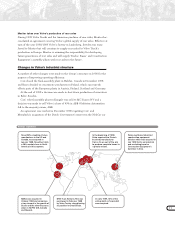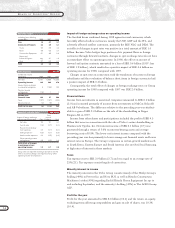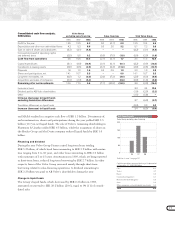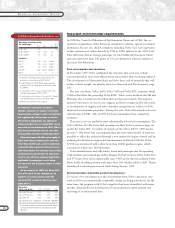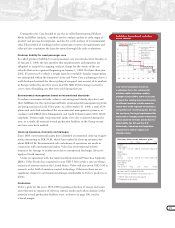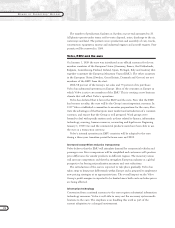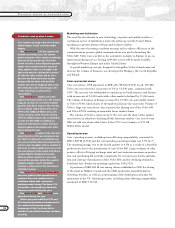Volvo 1998 Annual Report Download - page 23
Download and view the complete annual report
Please find page 23 of the 1998 Volvo annual report below. You can navigate through the pages in the report by either clicking on the pages listed below, or by using the keyword search tool below to find specific information within the annual report.
21
During the year Cars decided to use the so-called Environmental Failure
Mode and Effect Analysis, a method used to analyze quality in early stages of
product and process development, and also for early analyses of environmental
risks. This method of working involves systematic reviews of requirements and
risks and also constitutes the basis for more thorough life-cycle evaluations.
Producer liability for used passenger cars
So-called producer liability for used passenger cars was introduced in Sweden as
of January 1, 1998; the law specifies that manufacturers and importers are
obligated to accept for scrapping, without charge for the owner of the car,
vehicles that were registered beginning on January 1, 1998. Not later than year
2002, 85 percent of a vehicle’s weight must be recyclable. Similar requirements
are anticipated within the European Union and Volvo Cars is planning to have a
well-developed network for the recycling of scrapped cars in most of its markets
in Europe within the next few years. In 1998, SEK 40 M is being reserved to
cover costs of handling cars that were sold during the year.
Environmental management based on international standards
To reduce environmental risks, achieve cost-savings and clarify objectives and
their fulfillment in the environmental field, environmental management systems
are being introduced in all Volvo units. As of December 31, 1998, a total of 34
plants and units had introduced the environmental management system in ac-
cordance with EMAS (Eco-Management and Audit Scheme) and/or ISO 14001
standards. Twenty-eight environmental audits were also conducted during the
year: as a result, all majority owned production facilities in the Group except
one have now been audited.
Clean-up measures, insurance and damages
Since 1989, environmental audits have identified an estimated clean-up require-
ments amounting to SEK 90 M, which has resulted in clean-up measures for
about SEK 60 M. Environmental risk evaluations of operations are made in
connection with environmental audits. Volvo has environmental-related
insurance for damage to nearby areas due to unexpected discharges (does not
apply in North America).
Under an agreement with the American Environmental Protection Authority
(EPA), Volvo Trucks has committed to pay USD 5 M to settle a case involving
emission of nitrous oxide in the United States. Volvo will also invest USD 9 M in
research in the field of emission-control technology. Otherwise there are no
significant claims for environmental damages attributable to Volvo’s products or
plants.
Production
Volvo’s goals for the years 1995-1998 regarding reduction of energy and water
and reduction in emission of solvents, nitrous oxides and carbon dioxide at the
majority owned production facilities were, as shown on page 106, met by
a broad margin.
Emissions standards, nitrogen oxides, heavy vehicles,
USA and Europe g/kwh
8Euro 2
Step 1
Euro 3
US98
Euro 1
Step 3
Euro 4USO4
94 96 98 00 02 04
10
12
14
16
2
4
6
Trucks and buses,
European Union
Trucks and buses,
United States
Construction equipment,
European Union
Construction equipment,
United States
Step 2
92 06
Low fuel consumption has been
a voluntary focus for commercial
vehicles, while emissions, mainly
nitrogen oxides (NOx) were set by law.
To meet the varying legal requirements
in different markets, vehicle manufac-
turers have been required to develop a
comprehensive model program. During
the next year, the legal requirement for
emissions of nitrogen oxides from heavy
diesel-powered vehicles will be harmo-
nized within the EU and the U.S.
Historically, Volvo has met legislative
requirements well in advance of
effective dates.
Emissions, Volvo’s trucks and buses, g/km
CO NOx HC PM
Modern
diesel engine,
> 10 l. MK10.3-1.8 5.9-6.3 0.12-0.25 0.04-0.10
Modern
diesel engine
>10 l,
EU-fuel 0.3-1.8 6.3-6.8 0.11-0.24 0.05-0.12
Natural-gas engine
with catalytic
converter,
10 l och 6 l 2<0.3 2.0 <0.2 1<0.02
All values are EU certified, ECE R49
MK1= Diesel fuel, Swedish environmental class1
1 NMHC (Non-methane hydrocarbons)
2 Depending on gas quality
Legislative demands and emissions,
heavy vehicles


